This year's Consumer Electronics Show revealed a gigantic list of cutting-edge tech, and we're picking the best of the bunch.
As ever, the Consumer Electronics Show (CES) opened its doors to the public in the earliest weeks of 2025, but not before allowing the media to sneak in beforehand. Our team traveled to Las Vegas, Nevada, to get face time with manufacturers and go hands-on with the latest technology from each, including cutting-edge laptops, gaming handhelds, and practically everything else that runs (or supports) Windows.
Practically every brand you could think of was in attendance one way or another, and our eager Windows Central colleagues split up in search of the most exciting technology that could shake up the industry throughout this year. After all, iterating on specifications is fine, but showcasing interesting and unique devices will always catch our eye and often win awards. On that point, let's hand out our 15 awards for CES 2025, separating the latest winners by category.
Best laptop: ASUS Zenbook A14
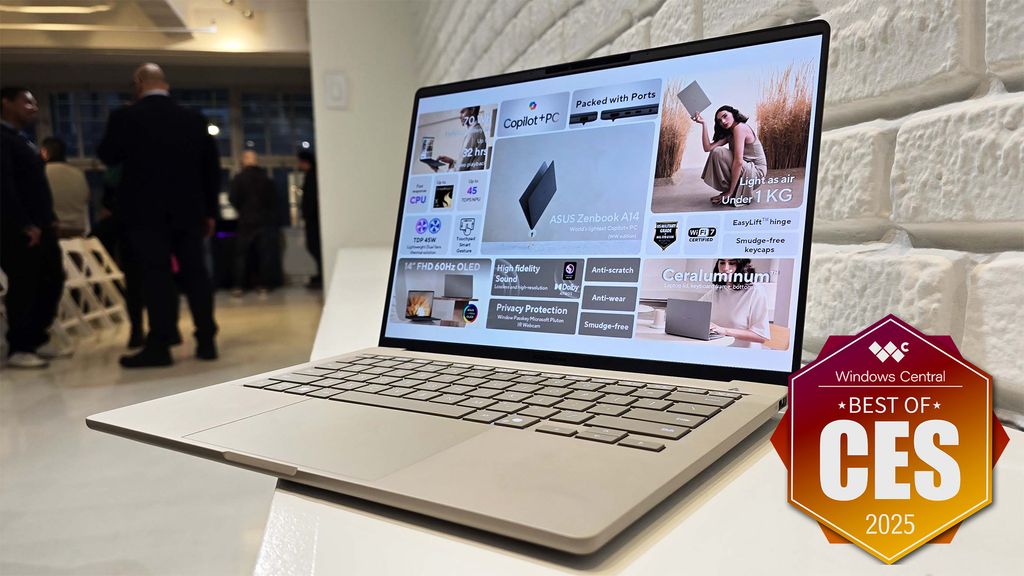
The new Zenbook A14 in "Zabriskie Beige."
(Image credit: Windows Central | Daniel Rubino)
We've recommended the best Windows laptops of each year for as long as I can remember, and our top picks almost always break above the $1,000 range. ASUS looks to change all that with the Zenbook A14, an ultra-lightweight laptop powered by Qualcomm's Snapdragon X (or X Plus) that starts at only $899. Previously codenamed "Zenbook Air," until ASUS' lawyers firmly rejected it for obvious 'fruit-related' reasons, it only weighs a baffling 2.18 lbs (0.98kg) thanks to a unique blend of 'Ceraluminum' coating across its entire chassis that previously appeared in its high-scoring Zenbook S 16.
It’s extremely light, feels great due to that Ceraluminum (and) looks beautiful with those “Earth-tone” colors.
Daniel Rubino, Windows Central Editor-in-Chief
Despite the almost hollow-feeling construction, ASUS squeezes a 70WHr battery into the Zenbook A14 and boldly claims "up to 32 hours of offline video playback." I remember when ASUS already managed a real-world 14+ hours in its Snapdragon X-powered VivoBook S 15, so there aren't many reasons for me to doubt the implied metric. It'll be available on Jan. 13, 2025 direct from ASUS for $1,099 with the new Snapdragon X (X1-26-100) chipset; oddly enough, the more tempting $899 entry-level pricing will actually be at Best Buy in March, and that model will feature the slightly more powerful Snapdragon X Plus (X1P-42-100).
In an interesting twist, ASUS told us they're making a version with Snapdragon X Elite, a higher-resolution 120Hz display, and 32GB of RAM. There are no details on pricing or which market that one will come to, but we're sure it'll be killer.
Best gaming handheld: Lenovo Legion Go S
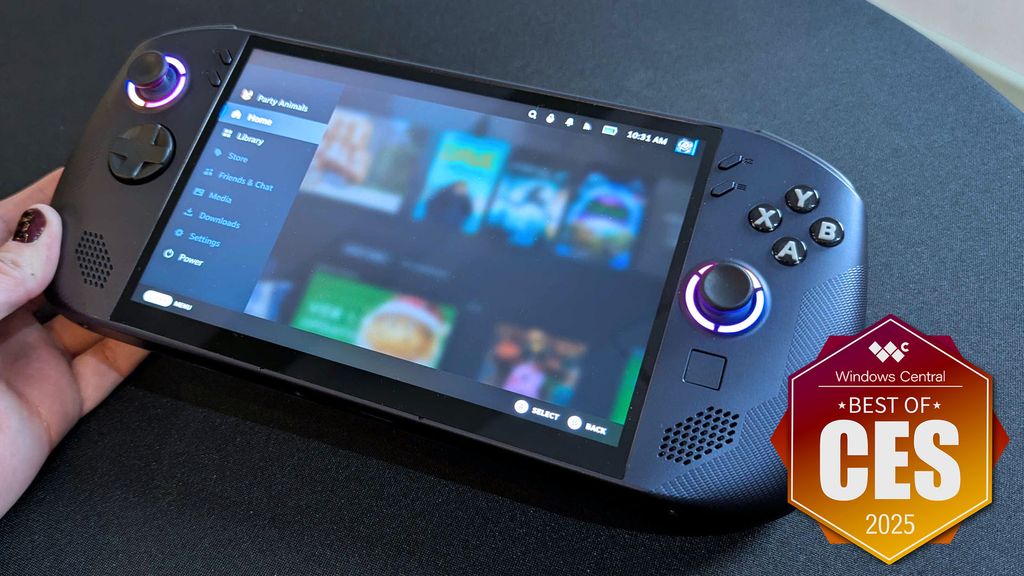
Lenovo Legion Go S running Valve's SteamOS.
(Image credit: Windows Central | Zachary Boddy)
An exciting shift is happening in the category of PC gaming handhelds, and it's being led by Lenovo and Valve. Rather than sticking to its Windows-based guns with an iteration on its well-received Legion Go from 2023, Lenovo is splitting its new Legion Go S into two categories: one with SteamOS and the other with Windows 11. Importantly, this new variant is dropping the detachable controllers of its predecessor in favor of a sleek redesign with a slightly smaller 8-inch, 16:10 IPS LCD display running at 120Hz with Variable Refresh Rate (VRR) support.
Inside, you'll find either AMD's affordable Ryzen Z2 Go chip or the Ryzen Z1 Extreme from previous 'premium' handhelds.
Zachary Boddy, Windows Central Staff Writer
While it might seem strange for Windows Central to celebrate a win for Valve's Linux-based operating system, the dream is for Microsoft to be strong-armed into improving Windows 11's performance and its overall user experience in the expanding handheld category. Besides, Windows and Linux have played nicely for years, and dual-booting is always an option for enthusiasts. Either way, the Legion Go S with Windows 11 looks great in white, but the SteamOS model has us more excited for the category, expected in May 2025 with a starting price of $499.99.
Best gaming laptop: Razer Blade 16 (2025)
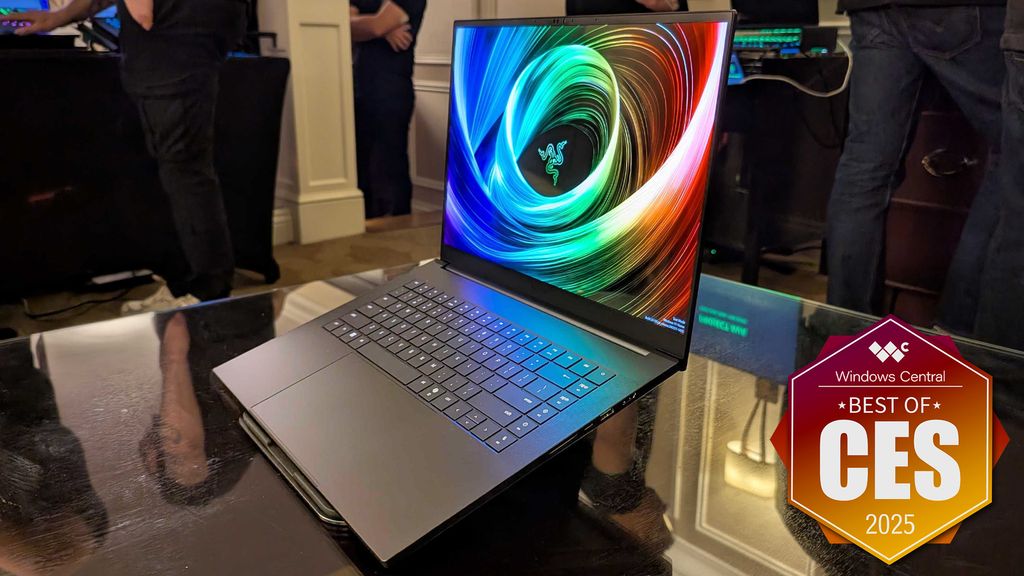
The redesign includes a new keyboard with deeper, more tactile, and more durable keys.
(Image credit: Windows Central | Zachary Boddy)
Razer's gaming laptops rarely disappoint, but the company's choice for a design overhaul on the new Blade 16 is something to celebrate. Reducing its entire chassis by 32% compared to last year's Blade 16 means this redesign is the thinnest Razer Blade laptop ever. Plus, it marks a shift from Intel chips to AMD as it features the same Ryzen AI 9 HX 370 as ASUS' creator-centric ProArt P16 (2024.) It also makes this the first Copilot+ PC from Razer (and its first AI PC in general.)
I could almost convince myself that Razer had used my review as the blueprint, addressing every single criticism I levied toward it.
Zachary Boddy, Windows Central Staff Writer
The processor switch-up means that RAM will now be soldered and non-replaceable, but this new Blade 16 supports up to 64GB at a massive 8,000MHz, a huge improvement over the 5,200MHz in its predecessor. Unfortunately, we don't expect to see this new variant until sometime in the first quarter of the year, so the full range of specs can't be verified just yet, but all signs point to an across-the-board improvement powered by . Refining to potential perfection, the new Blade 16 is extremely exciting.
Best 2-in-1 laptop: ASUS ROG Flow Z13 (2025)
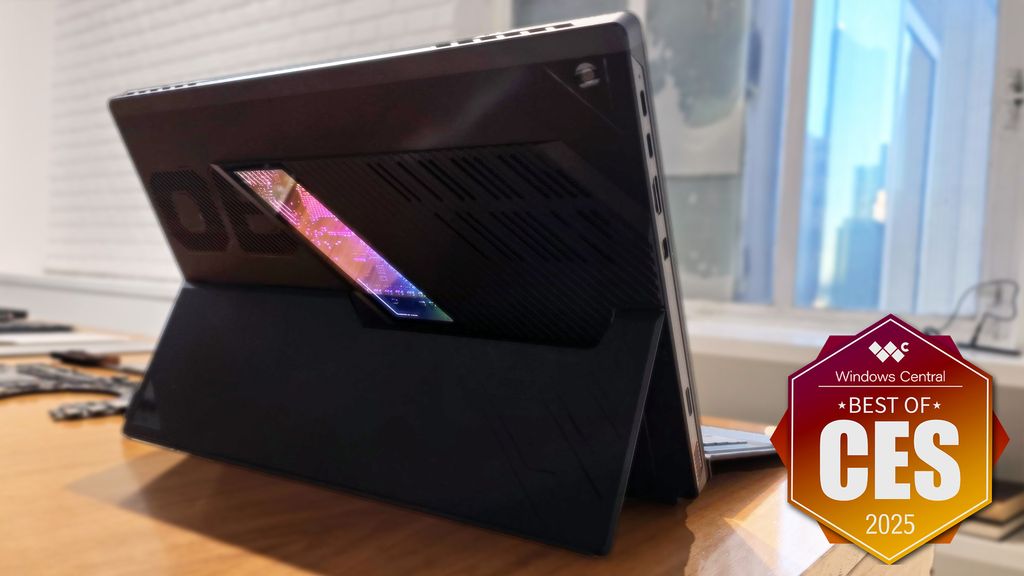
The Flow Z13 looks better than ever, with a window peeking into its internals.
(Image credit: Windows Central | Zachary Boddy)
At a glance, you'd be forgiven for mistaking ASUS' new ROG Flow Z13 (2025) for one of Microsoft's Surface Pro 11 variants. That's not a bad thing, as the company's Director of Technical Marketing, Sascha Krohn, described this redesigned 2-in-1 as a "Surface Pro for gamers" when I saw a sneak preview of a sample unit about a month before CES. It's a 13.4-inch tablet powered by a range of AMD processors, up to the new Ryzen AI MAX+ with its RDNA 3.5 integrated GPU.
It's wrapped in a CNC-milled aluminum chassis that measures barely 13mm in thickness and weighs 1.2 kg (2.64 lbs), but the focus will undoubtedly be on its potential for gaming performance. A built-in kickstand helps differentiate it from the latest gaming handhelds, like Acer's ridiculously huge Nitro Blaze 11, but it comes in a traditional 2-in-1 laptop format with its detachable keyboard reminiscent of ASUS' ProArt PZ13 that I tested earlier this year. If you snubbed the Surface Pro 11 for its gaming performance, the ROG Flow Z13 is for you, starting at $1,999.99 with a release date to be confirmed.
Best mini PC: Geekom QS1 Pro
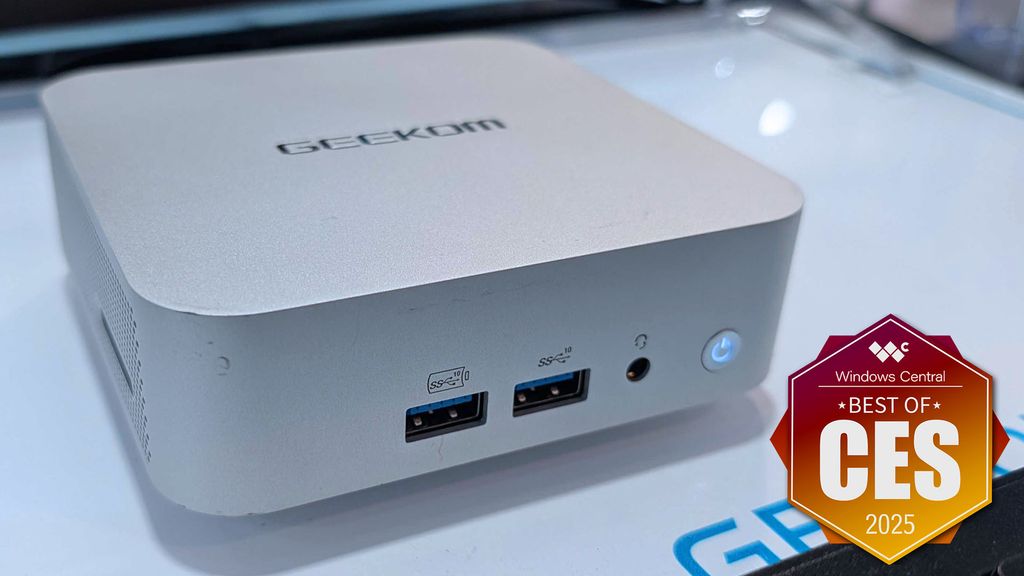
Geekom QS1 on display at CES 2025.
(Image credit: Windows Central | Rebecca Spear)
Standing out from the crowd, Geekom unveiled the world’s first Snapdragon X Elite-powered mini PC (technically, Lenovo announced the world's first Snapdragon X mini PCs as Geekom's won't be out until later), opting for the X Elite (X1E-80-100) running at 4.0 GHz — no small feat for a pint-sized PC. It's the first time we've seen Windows on ARM running on a desktop device, and Geekom has suitably impressed us over and over again with its previous miniature Windows desktops, so the QS1 should be no exception.
Featuring up to 64GB of LPDDR5x RAM running at 8400MHz and space for two M.2 SSDs (one 2280 and one 2242) supporting up to 2TB of storage space each, the QS1 also supports the latest USB 4 standard with a USB-C port. The 'Pro' in its name refers, at least partially, to its choice of Windows 11 Pro for its operating system with a built-in fingerprint reader for secure Windows Hello logins. It's an impressive spec sheet and a refreshing sign of advancement in the category after Qualcomm canceled its official Snapdragon X Elite devkit, and I'd be eager to get my hands on it.
Best All-in-One PC: HP OmniStudio X (2025)
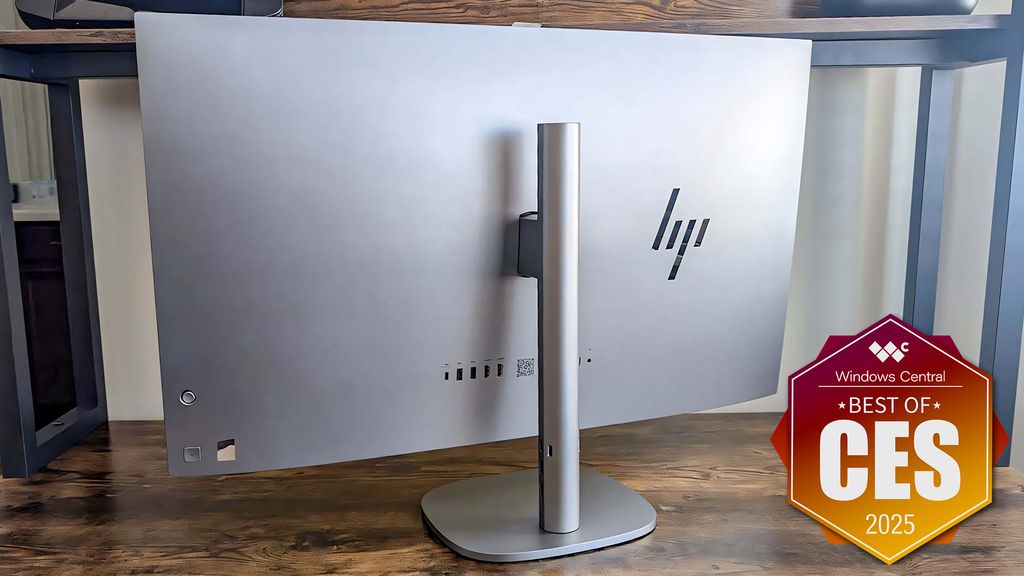
The OmniStudio X 2025 refresh shares the same appearance as the 2024 model.
(Image credit: Windows Central | Rebecca Spear)
HP refreshed its All-in-One PC lineup with the first-ever device in the category that's also a Copilot+ PC. The OmniStudio X (2025) builds on the well-reviewed OmniStudio X from last year by placing Intel Core Ultra 200V processors inside. That chip paves the way for the device to be a Copilot+ PC and powers AI features like Windows Recall, advanced Windows Studio Effects, Click To Do. Third-party apps can also take advantage of the All-in-One's NPU, running at 47 TOPS.
Our list of the best Windows AIO will likely gain a new member when the HP OmniStudio X ships. The device is configurable with up to Intel Core Ultra 7 258V processor, 32GB of LPDDR5X RAM, and 2TB of Gen4 NVMe SSD storage. 27-inch and 32-inch models will be available with either 4K or 1080p displays. Those screens have an anti-glare coating, support for HDR 600, and good color coverage as well. The All-in-One also has an HDMI-in port, allowing you to use the All-in-One as an external monitor, which is almost unheard of in All-in-One PCs these days.
Best Ultrabook: Yoga Slim 9i 14 (Gen 10)
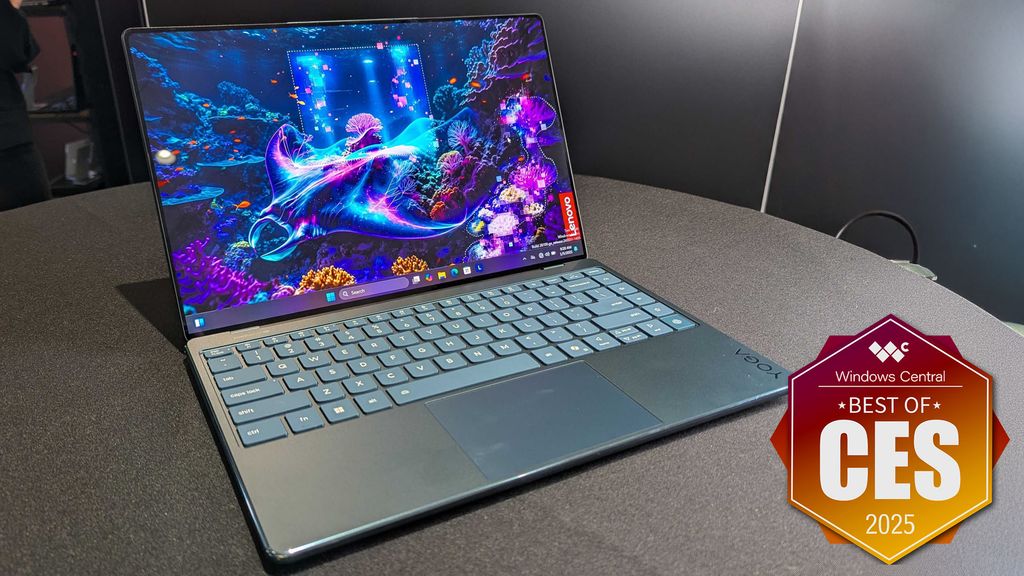
4K at 120Hz with 750nits brightness, Dolby Vision, and 100% of the most common color gamuts. This OLED screen is phenomenal.
(Image credit: Windows Central | Zachary Boddy)
Lenovo's Yoga Slim 9i has been a shining example of a high-quality Ultrabook for years, with each generation iterating close to perfection. The "luxurious" Lenovo Yoga Slim 9i (Gen 10) is no exception, standing out as arguably the shiniest laptop we've ever seen. It's coated in a "cat eye-like 3D sheen" with curved edges and a "PureSight Pro" OLED touchscreen, but the most interesting part is actually hidden behind this panel.
Not only does the front-facing camera feature a massive 32MP sensor, the first of its kind, but it's completely hidden underneath the display when it's inactive. When you need it, the camera appears like a small notch, much like the front screen of modern smartphones. Unfortunately, it doesn't support Windows Hello facial recognition, but Lenovo provides a fingerprint sensor on the keyboard as an alternative secure login. Starting at $1,849, it's expected to launch in February.
Best GPU: NVIDIA Blackwell GeForce RTX 50 Series
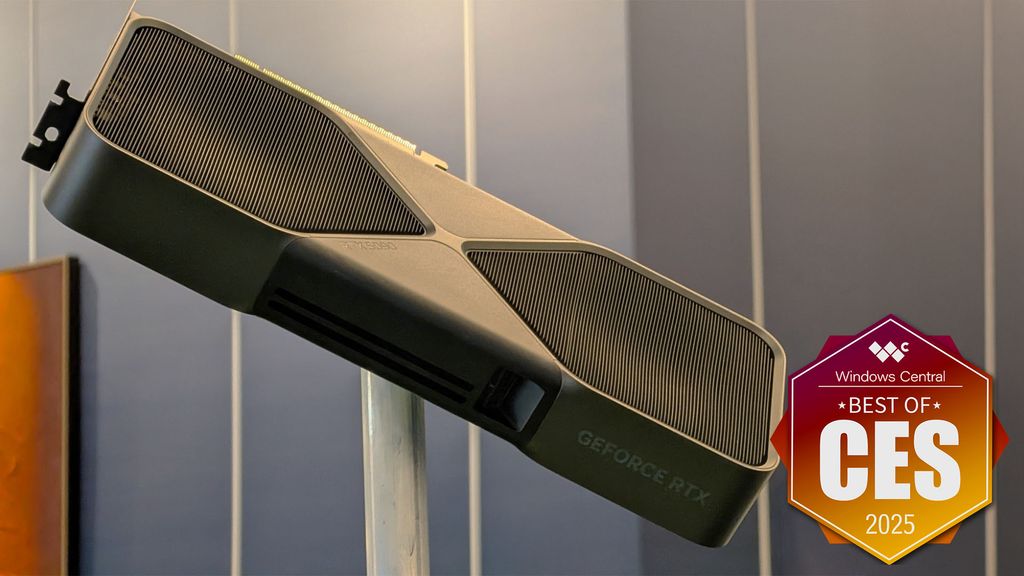
NVIDIA GeForce RTX 5090 on display at CES 2025.
(Image credit: Windows Central | Zac Bowden)
NVIDIA's CEO, Jensen Huang, visited this year's CES to deliver a keynote speech on everything his company is planning for 2025, including more AI expansion and even robotics. As interesting as that might seem to some, there was an undeniable expectation for him to announce specifications and pricing for the next generation of GeForce RTX graphics cards, which he indeed delivered. While the outlandish claims of "4090 performance" from the $549 RTX 5070 can't be confirmed just yet, the upscaling benefits of DLSS 4 are surely the crux.
Best of all, the RTX 50 Series cards have actually slimmed down compared to their extra-chunky RTX 40 Series predecessors, especially at the high end, which helps custom PC builders breathe at least one sigh of relief. Power draw will be another story, but PSU manufacturers are already increasing the average wattage with new models. It'll be an extremely exciting time when we get our hands on the new cards, particularly the all-powerful 5090, with the 50 Series landing in February.
Best business laptop: HP EliteBook Ultra 14 (G1i)
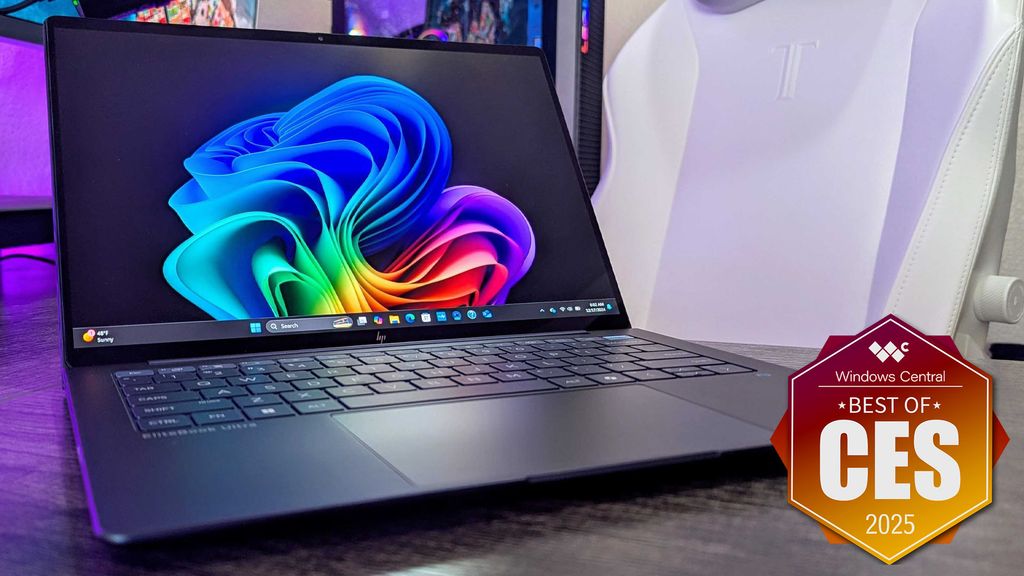
We're actually looking forward to this EliteBook.
(Image credit: Windows Central | Zachary Boddy)
Going hands-on with a pre-production sample of the HP EliteBook Ultra 14 (G1i) before CES started proved to be an eye-opening experience. With sleek rounded corners and a deep blue chassis reminiscent of premium consumer-focused Ultrabooks, the new EliteBook Ultra 14 features a high-end haptic touchpad and a gorgeous OLED display. It's an all-around winner with versatile Thunderbolt 4 ports alongside a USB-A holdover and Intel's latest Core Ultra (Series 2) processors under the hood.
Naturally, being a business laptop, HP focuses its attention on the NPU-driven boosts to security and Intel vPro certification. Still, a 9MP front-facing webcam pairs with a quad-speaker system and dual noise-canceling microphones to promise a premium experience in video meetings that doesn't feel like a cheap afterthought. Plus, two biometric login options support Windows Hello with facial recognition and a fingerprint sensor, which should please security-conscious system admins. Prices will start at $2,019 when it drops later this month.
Best innovation: Lenovo ThinkBook Plus (Gen 6)
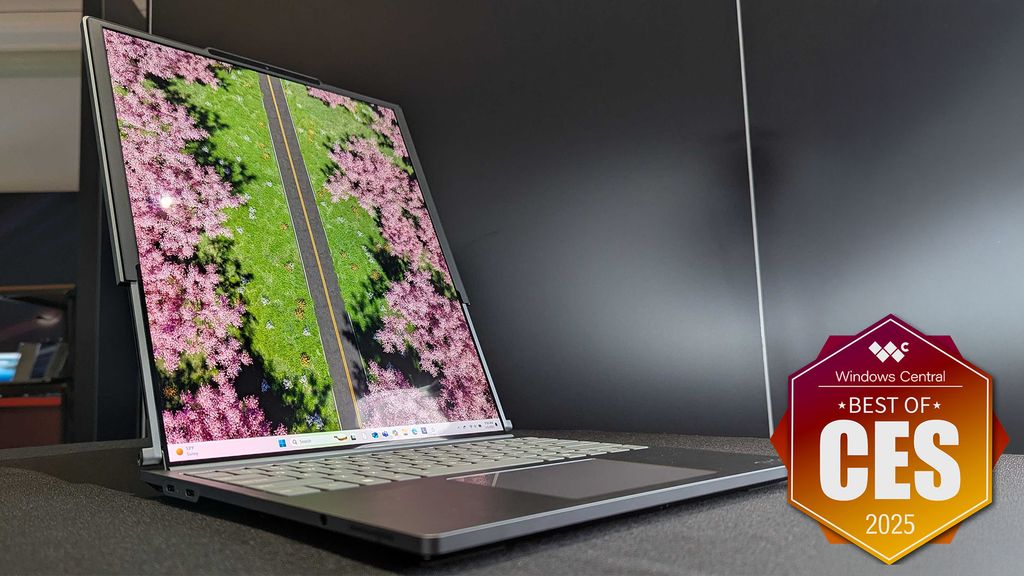
The ThinkBook Plus Gen 6 features a 14-inch display that unrolls to extend the screen to 16.7 inches.
(Image credit: Windows Central | Zachary Boddy)
Lenovo has always been on the forefront when it comes to innovating display technology. The company's Yoga Book 9i features two displays and the ThinkPad X1 Fold has a massive folding screen. So, it should come as no surprise that Lenovo pushed the limits of the laptop form factor once again with its ThinkBook Plus Gen 6. That laptop has a rollable screen that allows the display of the PC to expand vertically.
While it's on-brand for the ThinkBook Plus range to include a feature that's a little 'out-there,' I'm thrilled to see Lenovo adapt some genuinely exciting technology that could push the category in a unique direction.
Ben Wilson, Windows Central Senior Editor
Lenovo has played around with rollable display technology for years, including a concept device seen in 2022 and a prototype showcased in 2023. But the ThinkBook Plus Gen 6 is a bona fide product you can order. The laptop has a 14-inch display that can extend all the way to 16.7 inches if you push a button or wave your hand. An Intel Core Ultra 7 and Intel Arc Xe2 graphics power the new laptop, but the main draw of the device is its unique form factor, and the main driver behind the PC's price tag. The ThinkBook Plus Gen 6 will cost a whopping $3,499 and start shipping in Q1 2025.
Best desktop processor: AMD Ryzen 9950X3D
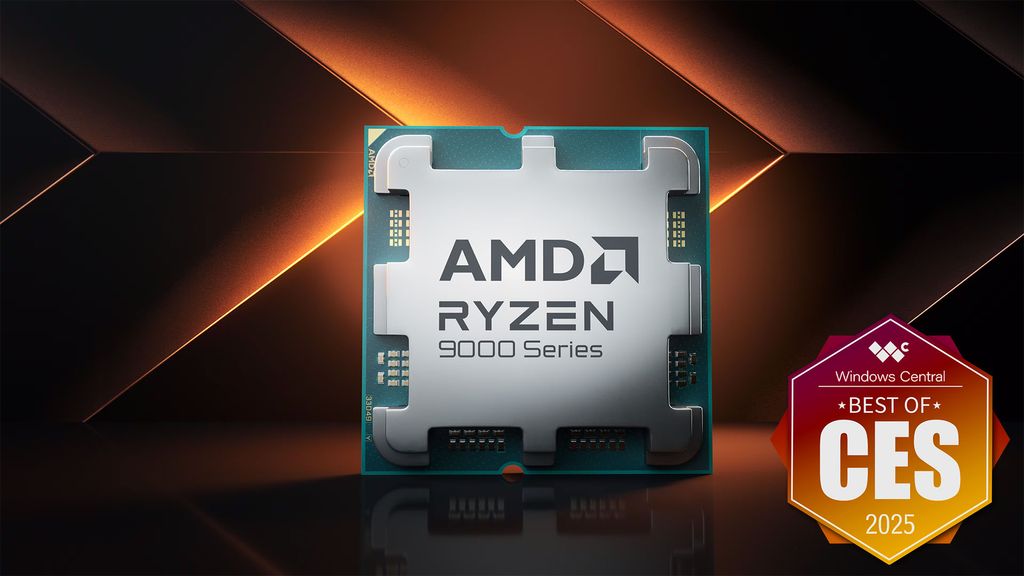
AMD Ryzen 9000 Series unveiled at CES 2025.
(Image credit: AMD | Windows Central)
AMD gave us a first look at its Ryzen 9000 “Zen 5” processors at Computex 2024, following up with the launch of new desktop chips in August 2024. It wasn’t until October 31, 2024, that we got our first taste of AMD’s Zen 5 X3D desktop CPUs in the form of the Ryzen 7 9800X3D with AMD’s exclusive 3D V-Cache technology. Not only did it “slam dunk” on Intel’s K-series Core Ultra Series 2 chips, but it quickly became the most coveted CPU for PC gamers.
AMD’s 3D V-Cache directly improves gaming performance, so that comes as little surprise. Also unsurprising is the announcement of a new Ryzen 9 9950X3D chip at CES 2025. While the Ryzen 7 remains the best option for gamers, the new 9950X3D takes the abundance of stacked cache and adds to its regular unstacked cache made for creative work. So far, there’s no mention of pricing, but we expect to see it well ahead of the Ryzen 7 9800X3D’s $479 MSRP.
Best laptop processor: Qualcomm Snapdragon X
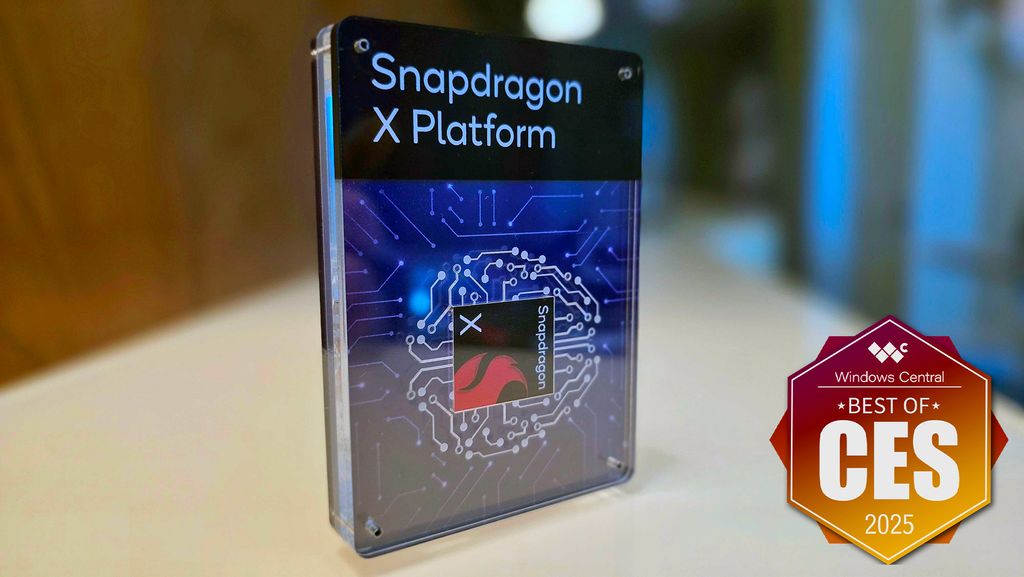
Snapdragon X plaque on display at CES 2025.
(Image credit: Windows Central | Daniel Rubino)
Following the revolutionary ARM-based Snapdragon X Elite and X Plus processors, Qualcomm unveiled yet another addition to its range with a simplistic 'Snapdragon X' title. Technically, it's a slimmed-down version of the 8-core X Plus chip, but with a max 3.0 GHz clock speed for the CPU and a GPU running at 1.7 TFLOPS. However, the same neural processing unit (NPU) remains, running at 45 TOPS and qualifying Snapdragon X devices as Copilot+ PCs and AI PCs with local processing.
Snapdragon X will, at the very least, cause some disruption in the budget-focused PC market, which could lead to more engaging competition from Intel or AMD.
Daniel Rubino, Windows Central Editor-in-Chief
Above all, the most notable part of Qualcomm's new processor is its target audience of “students, freelance workers, and budget-conscious consumers” since it'll power laptops starting in the $600 range. That's stripping the 'premium only' reputation of Copilot+ PCs away and opening the doors to the budget-conscious user who craves a modern device. It's an interesting addition to our awards because it's the opposite of the usual 'fastest-ever' chips, focusing instead on expanding the category in the direction of affordability.
Best handheld processor: AMD Ryzen Z2 Extreme

AMD Ryzen Z2 Series unveiled at CES 2025.
(Image credit: AMD | Windows Central)
PC gaming handhelds are growing at an incredible rate, with a wealth of manufacturers getting involved since Valve's Steam Deck legitimized the category. Kick-starting a new era of Windows-based handhelds with the Ryzen Z1 and Z1 Extreme powering some of our favorites like ASUS' ROG Ally X and Lenovo's Legion Go, AMD's follow-ups were revealed (slightly early) as the Ryzen Z2 Series at CES.
The Ryzen Z2 Extreme is the top model of this new category and acts as the chip to push portable performance even higher with a higher TDP limit and graphical spec bump. While we don't have concrete details about specific devices that will use the new Z2 Extreme processor, the real-world proof of its last-gen equivalent is enough to have me excited for this new variant to power my obsession with handheld PC gaming. Integrated graphics will be a big deal in 2025, and AMD is leading the pack.
Best gaming PC: Maingear Apex Force
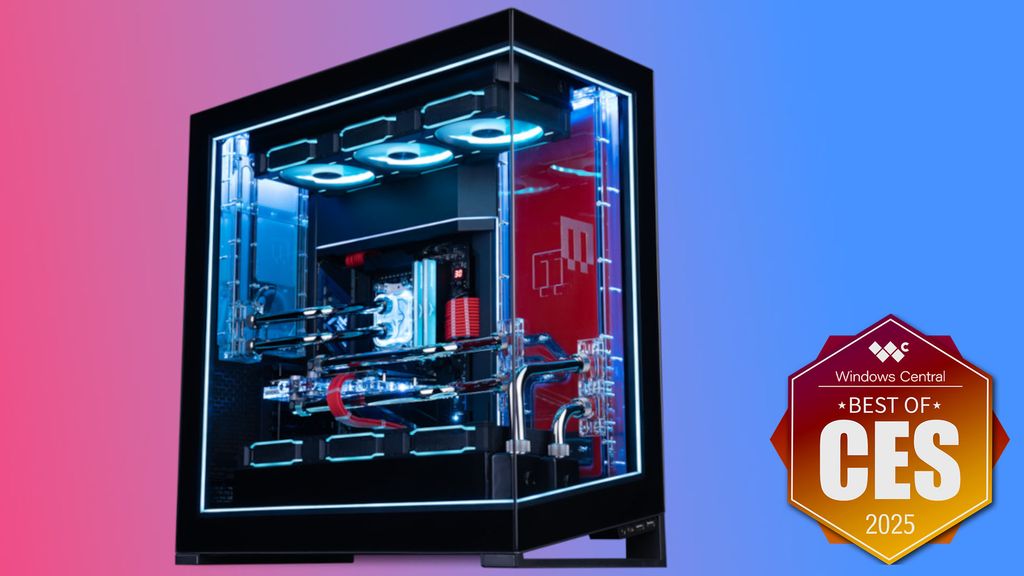
MAINGEAR's liquid-cooled APEX FORCE gaming desktop.
(Image credit: MAINGEAR | Windows Central)
MAINGEAR is always at the top of my list of recommendations. Built by hand in New Jersey with in-house support, they feel like they were built at home rather than on an assembly line. The company showed off two top-of-the-line pre-built desktops at CES 2025; the APEX RUSH is a refresh, but the APEX FORCE is completely new. The latter uses a Phanteks NV9 case, dual 420mm radiators, and dual custom cooling loops.
MAINGEAR hasn't set a launch date or pricing, but you can put down a fully refundable $100 deposit now.
Cale Hunt, Windows Central Contributor
It’s one of the best-looking pre-built PCs I’ve ever seen, and loop upkeep is easy with dedicated panels that reveal drain/fill ports and the pump. You can customize everything right down to the cabling with tubing materials, color, fittings, sleeves, and more. The FORCE is expected to arrive with NVIDIA’s latest RTX 5000 GPUs, the latest chips from AMD and Intel, and up to 96GB of DDR5 RAM in Q1 2025.
Best sustainable laptop: Acer Aspire Vero 16
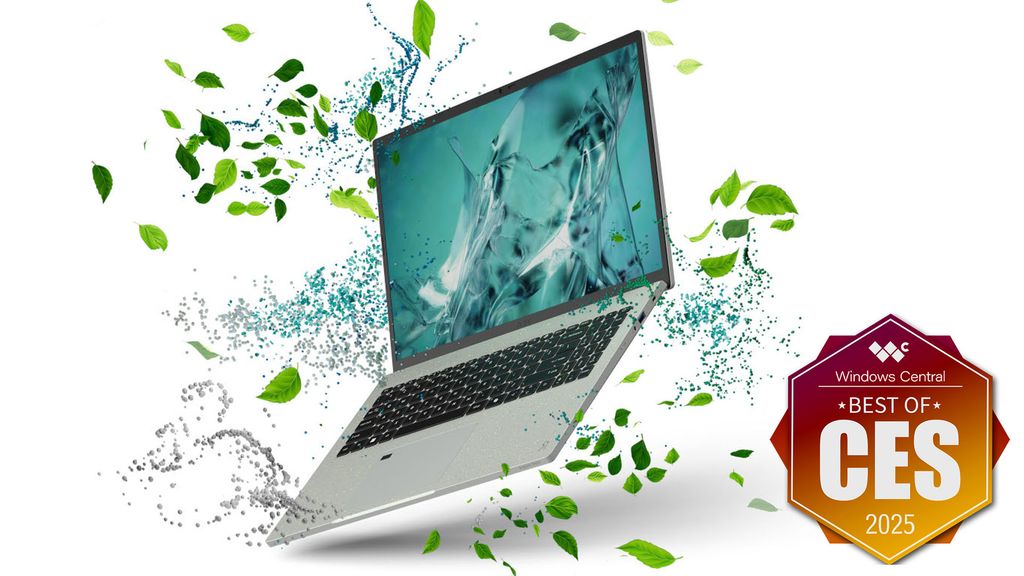
Acer's Aspire Vero 16 laptop is "carbon neutral."
(Image credit: Acer | Windows Central)
The new Aspire Vero 16 (AV16-71P) from Acer is an intriguing laptop that the company says will remain carbon neutral throughout its lifecycle, including “raw material, manufacture, distribution, use, and disposal.” Acer says that it's using high-quality carbon credits to offset any outstanding carbon emissions, which can't hurt, right? It makes these bold statements thanks, at least in part, to a clever redesign of its laptop.
Whether the Vero 16 will have a major impact on global pollution or not, I have to applaud Acer’s efforts.
Cale Hunt, Windows Central Contributor
The Vero 16 now uses 70% more recycled materials than before in its chassis, including post-consumer recycled (PCR) plastic and oyster shells (seriously.) It’s also had the walls of its chassis shaved down, and the touchpad is made from plastic pulled from the ocean. Despite all this, it looks like any other laptop save for the speckled finish. It’ll be available with Intel’s new Core Ultra H-Series 2 processors and up to 32GB of LPDDR5x RAM, expected to debut in April 2025, starting at $799.99.
Hope you enjoyed this news post.
Thank you for appreciating my time and effort posting news every day for many years.
News posts... 2023: 5,800+ | 2024: 5,700+
RIP Matrix | Farewell my friend ![]()
- dabourzannan
-

 1
1


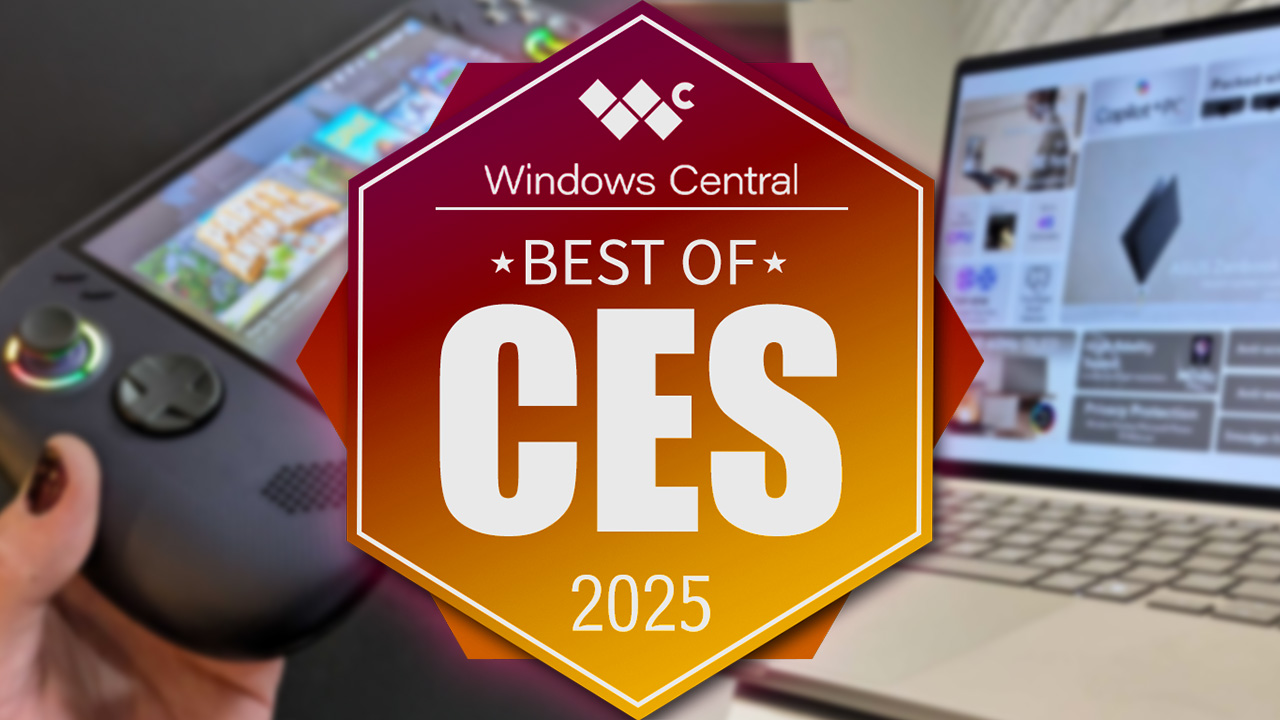
3175x175(CURRENT).thumb.jpg.b05acc060982b36f5891ba728e6d953c.jpg)
Recommended Comments
There are no comments to display.
Join the conversation
You can post now and register later. If you have an account, sign in now to post with your account.
Note: Your post will require moderator approval before it will be visible.